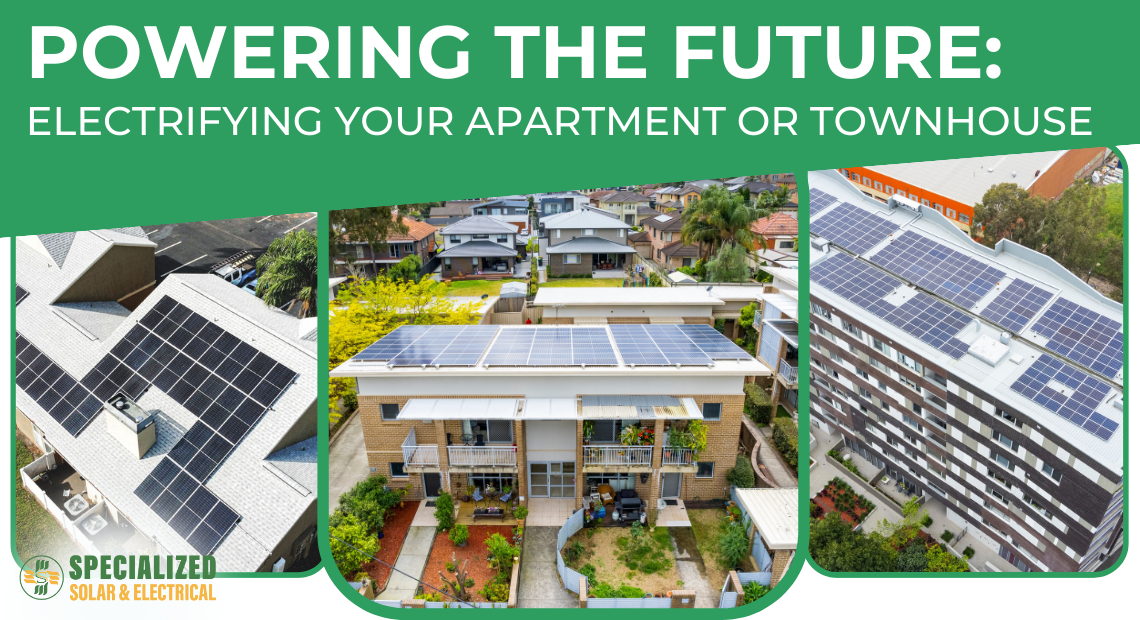The transition to a more sustainable and eco-friendly living environment is not just a trend; it’s a necessity. As the world grapples with the effects of climate change, there’s an increasing push towards adopting cleaner energy sources. One significant step in this direction is the electrification of residential spaces, including apartment buildings and townhouses. Here’s a detailed guide to help you understand and implement this change:
Understanding the Importance of Electrification
Electrification is more than just a buzzword; it’s a transformative approach to how we consume energy. Here’s a closer look at its significance:
1. Reduction of Greenhouse Gas Emissions:
- The Problem with Fossil Fuels: Traditional energy sources, like coal, oil, and natural gas, release significant amounts of carbon dioxide and other greenhouse gases when burned. These emissions trap heat in the Earth’s atmosphere, leading to global warming and climate change.
- The Electrification Solution: By transitioning to electric systems powered by renewable energy sources, such as wind or solar, we can drastically reduce these emissions. Unlike fossil fuels, renewable energy sources produce little to no greenhouse gases during their lifetime, making them a cleaner alternative.
2. Paving the Way to a Zero-Carbon Future:
- The Vision: A zero-carbon future is one where human activities release no additional carbon dioxide into the atmosphere. It’s a world where we’ve curbed the worst impacts of climate change and secured a sustainable environment for future generations.
- Electrification’s Role: By electrifying our homes, transportation, and industries, we’re reducing our reliance on carbon-intensive energy sources. This shift is crucial in achieving a balance where the carbon we emit is equal to or less than the carbon our planet can absorb.
3. Cost Savings in the Long Run:
- Immediate Costs vs. Long-Term Savings: While the initial investment in electric systems and appliances might be higher, the operational costs over time are often lower. Electric systems tend to be more efficient, require less maintenance, and are less prone to price volatility compared to fossil fuels.
- Benefiting from Technological Advancements: As technology continues to advance, electric systems and appliances are becoming more affordable and efficient. Additionally, as more communities invest in renewable energy infrastructure, the cost of electric power is expected to decrease, leading to further savings for consumers.
Assessing Your Current Energy Usage: A Closer Look
Understanding your current energy consumption is the foundation of any electrification project. It provides a clear picture of where you stand and what steps are needed to transition towards a more sustainable energy model. Here’s a detailed breakdown:
1. Determining Your Apartment’s Energy Consumption:
- Energy Bills Analysis: Start by examining your monthly utility bills over the past year. This will give you an idea of your average energy consumption, peak usage months, and any patterns or trends.
- Appliance Audit: Make a list of all the major appliances in your apartment, such as heating systems, air conditioners, refrigerators, and stoves. Note their make, model, and age. Older appliances tend to be less energy-efficient, consuming more power for the same output.
- Usage Habits: Reflect on your daily habits. Do you leave lights on when not in use? Is your thermostat set higher than necessary during winter? These habits can significantly impact energy consumption.
2. Identifying Areas for Electrification:
- Spotting Inefficiencies: Based on your energy bills and appliance audit, identify systems or appliances that consume excessive energy. For instance, an old gas water heater might be using more energy than a newer electric model would.
- Potential for Renewable Integration: Consider areas where you can integrate renewable energy sources. For example, if your apartment receives ample sunlight, it might be suitable for solar panel installation.
- Electrification Opportunities: Look for appliances or systems that can be replaced with electric alternatives. This could include replacing a gas stove with an induction cooktop or a gas heater with an electric heat pump.
- Behavioural Changes: Sometimes, the most significant savings come from simple behavioural changes. By being more mindful of energy consumption, such as turning off lights or unplugging devices when not in use, you can reduce energy waste.
Choosing the Right Appliances for a Sustainable Home
Embracing sustainability in your home starts with the right choice of appliances. The appliances you select play a pivotal role in determining your home’s energy efficiency and environmental impact. Let’s delve into the specifics:
1. Energy- Efficient Appliances:
- Why It Matters: Energy-efficient appliances consume less power for the same performance, reducing your energy bills and carbon footprint.
- Look for Ratings: When shopping, look for energy star ratings or other certifications that indicate the appliance’s efficiency.
2. Electric Alternatives to Gas Appliances:
- The Shift: Transitioning from gas to electric appliances is a significant step in home electrification. Electric appliances are often more efficient, safer, and environmentally friendly.
- Examples: Consider replacing gas stoves with electric or induction cooktops and gas water heaters with electric models.
Electrifying Heating and Cooling
Transitioning to electric solutions for heating and cooling is not just about modernization; it’s about optimising efficiency, safety, and control in your living space. Let’s explore the benefits and considerations of this electrification journey:
Electric Heating Solutions:
- Gas vs. Electric: Electric heaters are safer as they eliminate the risks associated with gas leaks. They also offer precise temperature control.
- Heat Pumps: These devices can cool your home in the summer and heat it in the winter, making them a versatile solution. They’re also highly energy-efficient.
The Joy of Electric Cooking
Stepping into the realm of electric cooking is like opening a door to a world of efficiency, safety, and precision. Whether you’re a seasoned chef or someone who enjoys occasional cooking, electric appliances promise an unparalleled experience. Here’s why:
1. Induction Cooktops:
- How They Work: Induction cooktops use electromagnetic fields to heat cookware directly, offering faster and more efficient cooking than traditional stoves.
- Safety and Precision: They’re safer as they remain cool to the touch and offer precise temperature control.
2. Electric Ovens:
- Even Cooking: Electric ovens often provide more uniform heat distribution, resulting in even cooking.
- Energy Efficiency: Modern electric ovens are designed to retain heat better, reducing energy consumption.
Rethinking Water Heating
Modern living demands efficient solutions, especially when it comes to essential utilities like water heating. Electric water heaters are not just about convenience; they’re about optimising energy use and ensuring consistent performance. Dive into the world of electric water heating and its advantages:
Electric Water Heaters:
- Types: Heat pump water heaters are highly efficient, while tankless models provide hot water on demand without the need for a storage tank.
- Insulation: Proper insulation ensures that the water remains hot for longer, reducing the need to reheat and saving energy.
Harnessing the Power of Renewables
Embracing renewable energy is more than a trend; it’s a commitment to a sustainable future. And with innovations like SolShare technology, even apartment dwellers can tap into the sun’s potential.
Solar Panels with SolShare Technology:
- Benefits: Solar panels, especially when integrated with Allume’s SolShare technology, can drastically cut down electricity bills. They empower homes, particularly apartments, to produce and share their own clean energy efficiently.
- Community Solar Solutions: For apartment dwellers who face challenges in installing individual solar panels, Australian-born cleantech company, Allume Energy provides a revolutionary solution. It allows multiple units within the same building to tap into and share solar energy from a single rooftop system, democratising access to renewable energy.
Collaborating with Building Management
Electrification is not just an individual’s journey; it’s a collective effort. When living in shared spaces, collaboration with building management becomes crucial. Here’s how to approach and navigate this partnership for a greener living space:
Proposing Electrification:
- The Process: Present a well-researched plan to your building’s management or homeowners’ association. Highlight the benefits, potential cost savings, and environmental impact.
- Seeking Approval: Collaboration is key. Work together to address concerns and find solutions that benefit all residents.
Staying Ahead of the Curve
To truly harness the benefits and navigate the challenges, one must be proactive, informed, and connected. Here’s how you can ensure you’re always a step ahead in this ever-evolving journey:
Continuous Learning:
- Evolving Technology: The world of electrification is rapidly evolving. Regularly research and stay updated on the latest technologies and solutions.
- Networking: Join forums or groups focused on sustainable living and electrification to learn from others’ experiences.
Becoming an Electrification Ambassador
Embracing electrification is not just a personal choice; it’s a movement. And every movement needs ambassadors—individuals who lead by example, share their stories, and inspire change in others. Here’s how you can become a beacon of change in the electrification journey.
Sharing Your Journey:
- Inspire Others: Share your experiences, challenges, and successes with friends, family, and neighbours. Your story can inspire others to take similar steps.
- Educate: Organise informational sessions or workshops to help others understand the benefits of electrification.
In conclusion, the journey to electrification is filled with choices and opportunities. Each decision you make brings you one step closer to a sustainable, eco-friendly home. Embrace the change, and remember: every small step has a big impact on our planet’s future. Contact us today












